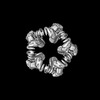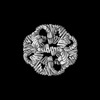+Search query
-Structure paper
| Title | Local structural flexibility drives oligomorphism in computationally designed protein assemblies. |
|---|---|
| Journal, issue, pages | Nat Struct Mol Biol, Vol. 32, Issue 6, Page 1050-1060, Year 2025 |
| Publish date | Feb 26, 2025 |
 Authors Authors | Alena Khmelinskaia / Neville P Bethel / Farzad Fatehi / Bhoomika Basu Mallik / Aleksandar Antanasijevic / Andrew J Borst / Szu-Hsueh Lai / Ho Yeung Chim / Jing Yang 'John' Wang / Marcos C Miranda / Andrew M Watkins / Cassandra Ogohara / Shane Caldwell / Mengyu Wu / Albert J R Heck / David Veesler / Andrew B Ward / David Baker / Reidun Twarock / Neil P King /       |
| PubMed Abstract | Many naturally occurring protein assemblies have dynamic structures that allow them to perform specialized functions. Although computational methods for designing novel self-assembling proteins have ...Many naturally occurring protein assemblies have dynamic structures that allow them to perform specialized functions. Although computational methods for designing novel self-assembling proteins have advanced substantially over the past decade, they primarily focus on designing static structures. Here we characterize three distinct computationally designed protein assemblies that exhibit unanticipated structural diversity arising from flexibility in their subunits. Cryo-EM single-particle reconstructions and native mass spectrometry reveal two distinct architectures for two assemblies, while six cryo-EM reconstructions for the third likely represent a subset of its solution-phase structures. Structural modeling and molecular dynamics simulations indicate that constrained flexibility within the subunits of each assembly promotes a defined range of architectures rather than nonspecific aggregation. Redesigning the flexible region in one building block rescues the intended monomorphic assembly. These findings highlight structural flexibility as a powerful design principle, enabling exploration of new structural and functional spaces in protein assembly design. |
 External links External links |  Nat Struct Mol Biol / Nat Struct Mol Biol /  PubMed:40011747 / PubMed:40011747 /  PubMed Central PubMed Central |
| Methods | EM (single particle) |
| Resolution | 7.1 - 8.0 Å |
| Structure data |  EMDB-42917: De novo designed KWOCA 18 nanoparticle - Assembly in D2 symmetry  EMDB-42919: De novo designed KWOCA 18 nanoparticle - Assembly in D5 symmetry  EMDB-42921: De novo designed KWOCA 70 nanoparticle - Assembly in D2 symmetry  EMDB-42924: De novo designed KWOCA 70 nanoparticle - Assembly in D3 symmetry |
| Source |
|
 Movie
Movie Controller
Controller Structure viewers
Structure viewers About Yorodumi Papers
About Yorodumi Papers



